
I have a confession to make. I’ve wanted to organize our library by genre for a really long time, but I honestly had no idea how I would find the time to do it. I don’t have an assistant in the library and I have about 1-2 volunteers for an hour each day. I teach tons of classes, collaborate with teachers, lead professional learning….the list goes on and on. However, because I’m doing all of these things, I watch students come into the library, find a book on the computer, and then have no idea where to get it because they don’t know how to use the Dewey system. Sure, I could spend hours teaching them how the secret code of the Dewey decimal system works, but when I’m trying to also teach the standards of every grade level, it’s hard to figure out how learning the Dewey Decimal system fits in. I’ve watched numerous of my inspiring professional learning network genrefy their collections: Tiffany Whitehead, Shannon Thompson, Sherry Gick, Donna MacDonald, Nikki Robertson,… I’ve sat in Jennifer LaGarde’s Zombie Librarian keynote numerous times and slouched down in my seat when she got to the part about how kids shouldn’t have to have a secret code to use the library. Every time I heard her, I knew reorganizing was what was best for students but I just didn’t know how to pull it off.
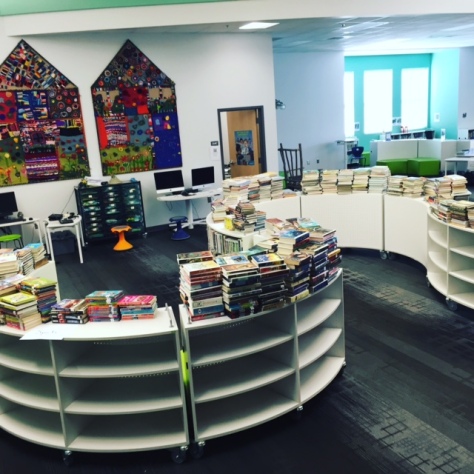
At the end of this school year, I decided that next year, I’m going to put a bigger emphasis on reading than I have the past few years. A big part of this is to get kids reading the kinds of books they want to read and helping them find those books quickly in the library. Most students come to the library and ask for sports books, scary books, princess books, superhero books, graphic novels,…..all genres. I’m at the point where I’ve attended enough sessions, read enough blogs, and listened to enough podcasts that I just have to jump in and start.
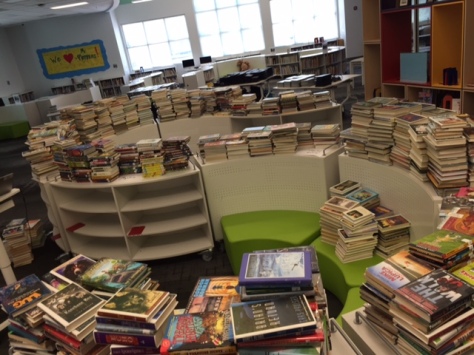
During my end of year evaluation, I told my principal what I was thinking about reorganizing the library, and I was so relieved to hear her say that it was exciting and she was all for it. She even told me she would support me in figuring out how to make it happen whether it’s delaying the opening of checkout at the beginning of the year or even having some workers help me in the evenings, weekends, or summer. I originally thought I would wait until the new school year, but every moment I had some time during post-planning, I couldn’t help myself. I jumped in.
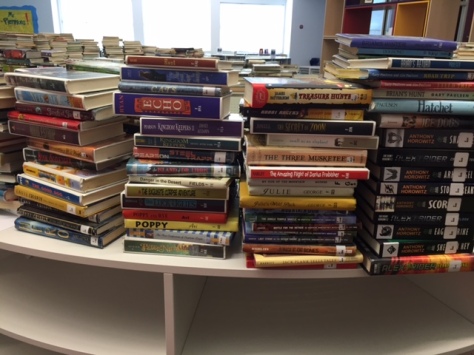
First, I decided to begin in the fiction section, which I’ve heard is the easiest section to start in. Based on my own observations and what I’ve read on other blogs, I decided on the categories of:
- mystery
- fantasy
- historical fiction
- sports
- humor
- realistic fiction
- scary
- adventure
- science fiction
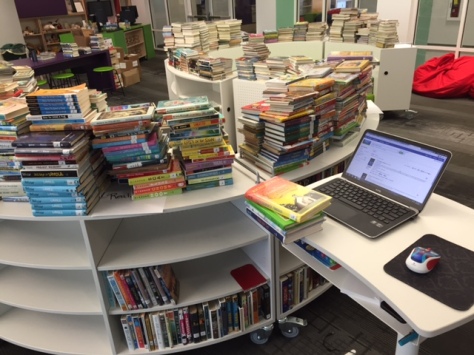
I put a sign on the top of each bookshelf for these genres and started pulling off a book at a time. I used multiple sources to help me decide on which genre to put them in:
- The book summary
- My own knowledge of the book
- The Library of Congress subjects in the front of the book
- Novelist K-8 in our Galileo database
Of course, there were books that fit into more than one category, so for those, I just picked a category. I believe it was Tiffany Whitehead who said that you should just think about what kind of reader would most likely choose that kind of book and let that guide the final category.
When I was stuck on a book and had no idea where to put it, I put it aside in a separate stack to come back to later. Those books might become another genre or they might vaguely fit into one of the genres I already had.
I worked on the fiction section just a little bit on day 1 and 2 of post planning, but day 3 was completely devoted to this project. I worked for about 5 hours on the final day to sort the books and push myself to get to the end.
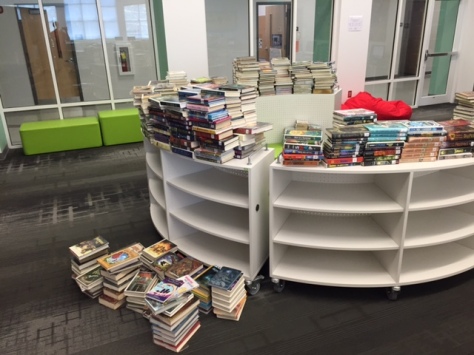
There were moments where I thought that I had made a big mistake, but the more I pushed on, the more I felt like I was doing the right thing.
Once all the books were sorted, I put them back onto the shelves by genre and labeled the carts because there are a few more steps to go. This will include scanning books into sublocations and adding a genre sticker to the spines.
I did weed the collection before I started, but touching every single book made me realize a few more needed to be weeded. Once books were sorted, I also could easily see which genres we had lots of books in and which we needed more. One of the obvious ones was sports. We have so many students who ask for sports books. We have a lot of nonfiction, but this made me realize how few sports fiction books we have.
If you are thinking about doing a project like this, definitely do your homework, but at some point, you just have to dive in. I’m thankful to all of the librarians who have done this before and left behind such careful instructions of what they did!

I genrefied the YA collections of all the public libraries I’ve ever worked in, but I have never taken the plunge to genrefy my K-5 collection (although I do use genre stickers, so many of them are genre-labeled anyway). Are you going to ditch the Dewey too? I’m so excited for you and your kids, and I’ll be really curious to hear what your students think of the change! Keep us informed.
I’m making very small inroads toward ditching Dewey… this year it was relabeling/recategorizing folktales by type & location instead of by author, and relabeling/recategorizing holiday books by holiday.
I’m still thinking about the nonfiction side of things and how I will reorganize that, but I will do something. I definitely want to get some things together that aren’t together like animals & pets, biographies within their content area…
I genrefied the fiction section over a year and the students love it! I am in a PK-4 and found it was easier than I thought it would be. I want to simplify my nonfiction section this year and am nearly done with the inventory of the section. Next is to weed as it has not been done in many years. Then put stickers based on subject on the spines (like I did with fiction). I mean, shouldn’t books about wild horses be easy to find? I organized my picture books by reading level and color (gold is 0.1-0.9 AR Reading Level, blue is 1.0-1.9, etc). The kids like this as we are a heavy AR school in grades 2-4.
Still thinking on the picture books. We don’t level, so I will need to think about logical categories. I definitely want to move nonfiction around so that similar topics are together like animals and pets. Glad to hear it has been working well!
It is a HUGE under taking but you and your students will be so glad you did it! I have loved having my fiction genrefied.
I meant to also say that I added an “animal” genre for those kids that wanted “a chapter book about animals” but not necessarily fantasy books. I have things the like Humphey series by Birney, Shilo., Hank the Cowdog, Geronimo Stilton in this genre. Whereas Erin Hunter’s Warriors, Edward Tulane and such are in fantasy.
How will the books be organized on the shelf within each category? How will you be changing the location in the MARC record?
Thanks for sharing your process/experience. I’m Not There Yet (after just one year in my school, I still don’t have a clear picture of my whole collection), but this made me think I will have to get there eventually. I have a library split down the middle, with fic on one end and NF on the other – which makes things hard for the primary kids. I think that’s my first priority, to bring those areas together more for primary in particular.
My library has a couple of distinct sections. Is genrefied, picture books are levelled, nonfiction is Dewey but I’m working on simplifying the sections, and reference has it’s own area. As we are adding more e-books and using more online reference material, these sections will adapt. Good luck!
[…] but just wasn’t sure how to make it happen. I started the process at the end of last year by sorting the fiction section. Over the summer, I looked at many other libraries who have done this process as well as attended […]